When we think of Marbella, golden beaches, exclusive restaurants and the glamour of Puerto Banús come to mind. But did you know that the surroundings of this famous town hide wonders that deserve to be explored? If you are wondering what to see near MarbellaFrom Visitanddo.com we leave you with a list of 8 places to see near Marbella. From picturesque white villages to nature adventures, here is a list of places that will make you fall even more in love with the Costa del Sol.
If you are short of time and don't want to worry:

Only one hour from Marbella, Ronda awaits you with its imposing new bridge connecting the two sides of the city, separated by a deep gorge.
One of the most important points emblematic is the "Puente Nuevo"The bridge is a masterpiece of engineering built in the 18th century. This bridge, which connects the San Francisco district with the City district, rises over a deep gorge more than 100 metres high, offering spectacular views of the Ronda gorge and the hanging houses overlooking the abyss. In addition, from the viewpoint of the New BridgeThe bridge, visitors can admire the panoramic view of the city and the surrounding natural environment, with the Guadalevín river meandering in the background. This bridge is not only a symbol of Ronda, but also a testament to its history and its ability to attract tourists from all over the world.
Another must-see to visit in Ronda is the Bullring. Built in 1785, it is one of the oldest in Spain and boasts a unique architecture. neoclassical. The bullring has witnessed some of the most famous bullfights in history and is known for its importance in the world of bullfighting. bullfighting. In addition to the bullfighting, inside you can visit the Bullring MuseumThe exhibition includes objects related to the bullfighting tradition, as well as portraits and historical documents. This visit allows visitors to better understand the cultural context of Ronda and its link with the bullfighting tradition. bullfightingThe art is still very much alive in the region.
The Old Town of Ronda is another major attraction for tourists. This neighbourhood encloses narrow cobblestone streetsIt is a place where you can take a journey through the history of the city. Here you will find monuments such as the church of Saint Mary MajorBuilt on the site of a former mosque, its façade reflects its Islamic origins. In addition, the Mondragon Palacewhich houses an archaeological museum, allows visitors to delve into the city's rich history, from Roman to Moorish times. The Old Town also has natural viewpoints The hotel offers panoramic views of the Serranía de Ronda and the Tagus, making it an ideal place to explore the beauty and history of this ancient city.
If you don't want to worry about transport, choose the excursion to Ronda from Fuengirola:

If you are an adrenaline lover, on Caminito del Rey is an obligatory stop. This trail
is one of the most impressive and spectacular footpaths in Spain, located in the province of Malaga, in the Antequera region. Originally built in 1905 as an access route for workers building a reservoir, the trail is suspended on the walls of the Guadalhorce river gorge, at a height of over 100 metres. The originality of the route lies in its aerial layout, with suspended walkways, platforms and narrow balconies running through the gorge. The narrowness of some sections and the panoramic views it offers of the Guadalhorce canyon make it a unique experience, accessible only by prior reservation and with specialised guides to guarantee the safety of visitors.
Walking along the Caminito del Rey is to enter a natural environment of breathtaking beauty. Along the 7.7-kilometre route, visitors pass through tunnels carved into the rock and overhanging walkways that allow close-up views of the local flora and fauna. The Gaitanejo Gorge and Los Gaitanes Gorge are some of the highlights, offering views of vertical cliffs and vegetation-filled rock faces. In addition, the route includes stops at rest areas that provide information about the history and geology of the area, as well as the local fauna. El Caminito del Rey is a place where you can experience nature at its wildest, accompanied by an in-depth knowledge of the history of the construction of this trail.
The Caminito del Rey has recently been restored to ensure the safety of visitors and to preserve it as a unique tourist attraction. The refurbishment, which was completed in 2015, included the construction of new walkways, platforms and stairs that comply with current safety regulations. This has allowed the Caminito del Rey to become an accessible tourist attraction for a wider public, including people of all ages looking for a unique experience in nature. During the walk, visitors can enjoy spectacular views of the gorge, the Conde de Guadalhorce reservoir and the peaks of the Sierra de las Nieves mountains. This engineering work has been an example of recovery and conservation of the natural heritage, allowing tourists to explore a wild and unknown environment for many.
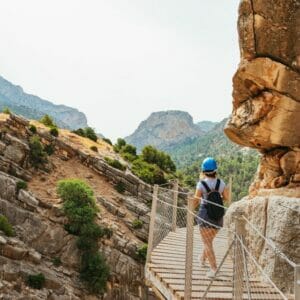

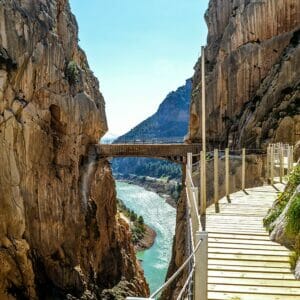

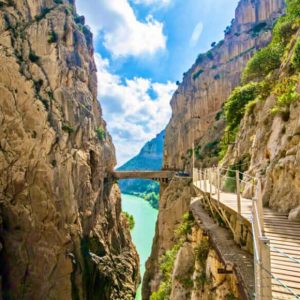

Mijas Pueblo, with its white houses adorned with flowers, is a perfect place to soak up the authentic Andalusian spirit. Only 30 minutes from Marbella, this picturesque white people is situated some 428 metres above sea level, offering spectacular panoramic views of the coastline and surrounding mountains. Its maze of narrow cobbled streets, whitewashed houses and hanging flowers on balconies and patios create a picturesque and authentic atmosphere. In addition to its visual beauty, Mijas is renowned for its Arab heritageThis is reflected in its architecture and the organisation of the town into neighbourhoods. Among its main attractions are the Constitution Squarewhere the church of the Immaculate Conception is located, and the Mijas Contemporary Art Centrewhich hosts exhibitions of local and international artists.
The Mijas Donkey Taxi Association is one of the symbols of the village.offering a donkey ride through the steep and narrow streets of Mijas. This centuries-old tradition allows tourists to explore the village in a fun and educational way, while familiarising themselves with local history and legends. In addition to the donkey-taxis, Mijas Pueblo offers a wide range of activities for visitors, such as hiking routes in the surrounding area of the Sierra de Mijas, where you can observe breathtaking scenery and enjoy nature. The Mijas Museum is also a must-see, presenting the history of the village from Roman times to the present day, with a collection of historical artefacts, photographs and documents illustrating life in this region over the centuries.
The Mijas market is an important meeting point for tourists and locals alike. Here you can find fresh produce, handicrafts and local products, such as the famous Malaga sweet wine and extra virgin olive oil. Mijas is also known for its gastronomy, with specialities such as pescaíto frito (fried fish), boquerones (anchovies) and migas (fried breadcrumbs), traditional dishes that visitors can enjoy in one of the many bars and restaurants in the village. Also of note is the Lamb stewA typical dish of the region that is served in many of the local taverns. The welcoming atmosphere and hospitality of the Mijeños make this market a perfect place to immerse yourself in the culture and traditions of Mijas Pueblo, whilst enjoying a pleasant day out in picturesque surroundings.
Enjoy a day trip to Mijas, Marbella and Puerto Banus from Malaga and different pick-up points on the Costa del Sol.

For lovers of the great outdoors, the Sierra de las Nieves National Park is a treasure to be discovered. Just a few kilometres from Marbella, this natural site offers hiking routes through forests of Spanish firs, rivers and viewpoints with panoramic views. It is an ideal place to disconnect and enjoy nature.
extends over more than 18,900 hectares and is known for its great ecological diversity and rich landscape. The sierra is home to one of the highest concentrations of endemic species of flora and fauna in the region, including trees such as the Spanish fir, an endangered Iberian fir. This unique ecosystem has been declared UNESCO Biosphere Reserve due to its ecological importance and its role in the conservation of biodiversity. In addition, the Sierra de las Nieves has numerous trails and mountain routes that allow visitors to explore its spectacular scenery, such as Torrecilla, the highest peak in the sierra at 1,919 metres.
The Sierra de las Nieves Natural Park is famous for its high mountain landscapeThe area is made up of impressive rock formations, caves and deep gorges. Nature lovers and hikers will find a wide variety of routes in this area, ranging from easy walks to more challenging trails, such as the Pinsapar roadwhich leads through forests of Spanish firs and offers panoramic views of the surrounding countryside. In addition to its natural beauty, the park is home to a rich fauna, including species such as the griffon vulture, Iberian lynx and golden eagle, which can be observed in their natural habitat. The Water Cave is another of the sierra's jewels, a large cave with unique formations and a stream running through it, offering visitors a fascinating underground experience.
The Sierra de las Nieves is also of great cultural and historical value. Archaeological remains dating back to prehistoric times have been found in its valleys and mountains, as well as ancient hermitages and water mills that recall the life of the inhabitants in times gone by. The white villages scattered throughout the sierra, such as Yunquera, Tolox and El Burgo, are known for their traditional architecture and rural charm. In these towns, visitors can enjoy the local gastronomy, such as the typical dish of "sopa campera" or extra virgin olive oil, as well as taking part in local festivities, such as the honey fair in Yunquera. The Sierra de las Nieves is therefore an ideal place for those looking to combine active tourism with relaxation and immersion in Andalusian culture.

Although known for its beaches, Estepona hides a historic quarter full of charm. Strolling through its streets decorated with colourful flowerpots and discover its artistic murals is a perfect place to visit near Marbella. In addition, the promenade is ideal to enjoy a quiet afternoon.
Known as the "Jewel of the Costa del Sol", Estepona offers a perfect combination of history, culture and heavenly beaches. The historic town centre is full of narrow cobbled streets, whitewashed houses with hanging flowers and picturesque wooden balconies. Estepona also boasts a lively marina, where visitors can enjoy boat trips, water sports or simply relax in one of the many bars and restaurants overlooking the sea. The Plaza de las Floreswith its terraces and trees, is a perfect place to enjoy the local gastronomy and immerse yourself in the Andalusian atmosphere.
One of Estepona's greatest attractions is its coastline, which stretches for more than 20 kilometres of fine sandy beaches and crystal clear waters.. Estepona's beaches are ideal for families and tourists looking for sun and sea, with options ranging from the quietest and most secluded to the busiest and most active. Playa del Cristo and Playa de la Rada are some of the best known and offer services such as sun lounger hire, beach bars and sports activities such as paddle surfing and beach volleyball. In addition, Estepona has modernised its promenade, creating an extensive pedestrian area with gardens, fountains and modern sculptures that embellish the view and provide a pleasant place to walk at sunset.
The cultural and leisure offer in Estepona is wide and varied.. The town has several museums, such as the Ethnographic Museum, which displays local history and traditions, and the Archaeological Museum, which houses artefacts from Roman and Phoenician times found in the region. In addition, the New Golden Mile is a residential and commercial area that has undergone significant development in recent years, offering high quality golf courses, shopping centres and luxury resorts. Estepona is also known for its calendar of festivals and events, such as the Feria de Agosto, where visitors can enjoy flamenco shows, concerts and religious processions, providing a total immersion in Andalusian culture.

The Artola de Cabopino Dunes, located on the coast of Marbella, are one of the few remaining dune ecosystems in the area. Costa del Sol. These golden sand dunes extend from the beaches of Artola to the marina of Cabopino. They are a protected site due to their ecological importance, as they are home to a wide variety of flora and fauna, including native fauna that is adapted to this special environment. In this area you can find everything from small bushes and plants of sandy soils to birds such as the kentish plover, an endangered bird that nests in the dunes. The Artola Dunes They are not only a haven for biodiversity, but also offer stunning natural scenery for visitors seeking a peaceful retreat from urban life.
These dunes are an ideal place for hiking and the practice of sports such as kite surfing and wind surfing, due to the constant winds. that occur in the area. Along the path along the dunes, walkers can enjoy panoramic views of the nearby beaches and the surrounding natural environment. The path also offers shady areas with pine and cork oak trees, ideal for taking breaks and enjoying a picnic overlooking the sea. As you walk along the path, you may come across ancient watchtowers and the remains of buildings built in the past to protect the coast from pirates. These towers, built between the 16th and 17th centuries, form part of the system of fortifications that stretched along the region's coastline.
Artola Beach, located next to the dunes, is a popular spot for tourists and local residents looking for a more relaxed and less crowded atmosphere than other beaches in Marbella.. The beach has services such as sun loungers and umbrellas for rent, as well as beach bars offering local specialities such as fresh fish and Andalusian tapas. In addition, Artola Beach regularly hosts activities and events to promote care for the environment, such as beach clean-ups and environmental education workshops. This unique and protected natural environment has become a haven for those who wish to enjoy the tranquillity of nature without giving up the comforts of modern life. This corner is perfect for strolling through trails surrounded by greenery, enjoying the sun on its beaches and admiring its unique environment. Considered one of the best beaches in Marbella.

Gibraltar is known for its Gibraltar StoneThe rocky monolith that stands as a symbol of the city, towering majestically over the strait that bears its name. This rock, 426 metres high, is an emblematic site offering breathtaking panoramic views of the Strait of Gibraltar, from where the coast of Africa can be seen on clear days. In addition to being a strategic point for the control of maritime traffic, the Rock of Gibraltar is a refuge for a colony of macaquesThe only wild primates living in Europe. At its summit, there is a monument to the Sacrificededicated to the fallen of the Second World War and commemorates the historic military importance of Gibraltar in the defence of the Allies.
The Gibraltar Museum offers an insight into the history and culture of the territory.The museum is a museum of the history of the city, from its prehistoric origins to its influence on the world wars and the present day. It exhibits an extensive collection of artefacts and historical documents, including artefacts from the Bronze Age, the Phoenician and Roman occupation, and the Napoleonic battles. The museum also shows Gibraltar's evolution as an important trading port and its development as a multicultural society influenced by diverse cultures and religions. In addition, it has a section dedicated to the flora and fauna of the region, including the biodiversity found on the Rock of Gibraltar Nature ReserveThe park is a protected area that is home to a rich variety of endemic species.
One of Gibraltar's main attractions is its privileged location, which makes it a strategic place for shopping.. The Main Street is Gibraltar's shopping centre, where visitors can find international brand shops, local boutiques and duty-free markets. Here you can buy everything from perfumes and cosmetics to watches and jewellery at competitive prices. In addition, the city offers a vibrant nightlife with traditional pubs, restaurants serving international cuisine and entertainment venues that reflect the cultural diversity of the population. Gibraltar is also known for its gastronomic offerwhich fuses British, Mediterranean and African influences, offering dishes ranging from fresh fish to Spanish tapas.
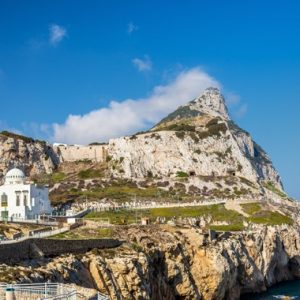



Fancy an international adventure? From Marbella, you can get to Tetouan in less than a day by taking the following route a ferry from Algeciras o Tarifa to Tangier. Tetouan, known as the "White City" of Morocco, is a destination steeped in history and culture. Founded in the 8th century, it has been a melting pot of civilisations that has influenced its architecture, language and traditions. The medina of Tetouan, a UNESCO World Heritage Site, is a labyrinth of narrow streets and white houses with inner courtyards. Here, visitors can lose themselves among craft shops, colourful souks and markets selling local products such as spices, textiles and ceramics. The city is also home to historic buildings such as the Grand Mosque, which dates back to the 12th century and is one of the oldest examples of Almohad architecture in Morocco.
The Kasbah of Tetouan is another of the city's architectural treasures.The Kasbah is a stunning sight overlooking the Strait of Gibraltar from its ramparts. Built in the 16th century, the Kasbah is a reflection of the Andalusian influence in Morocco, with its labyrinthine design of covered courtyards and corridors. Inside, visitors can explore the historic governor's residence and enjoy the tranquillity of the surrounding gardens. The Kasbah also houses the Museum of Art and Traditions of Tetouan, which displays a rich collection of costumes, jewellery and ceramics representing Rifian and Moroccan culture.
Everyday life in Tetouan revolves around cultural practices and traditions. that are kept alive in the day-to-day lives of its inhabitants. Open-air markets and craft shops offer an authentic insight into local life, where traders sell fresh produce and traditional products such as argan oil and hand-dyed fabrics. In addition, the city is known for its rich and varied gastronomy, which includes dishes such as couscous, tagine and fresh fish cooked in local herbs and spices. Tetouan is also a hotspot for artistic creativity, with pottery, Arabic calligraphy and embroidery workshops showcasing the skills of local craftsmen.

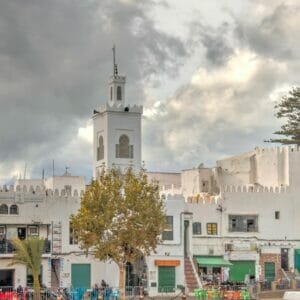



You may also be interested in
Marbella is not only a destination for luxury and beach lovers, it is also an ideal starting point for exploring the magical corners of the Costa del Sol. From charming villages to breathtaking natural landscapes, now you know what to see near Marbella.
Download the eBook for FREE!
Malaga in 3 days - The perfect route



If you liked...
Share!
"RIOS TRAVEL SL has been a beneficiary of the European Regional Development Fund whose objective is to improve the use and quality of information and communication technologies and access to them and thanks to which it will carry out "web presence through SEO" "online promotion service" "RRSS Dynamization" and "Development of audiovisual promotional material for use on the internet" to improve the competitiveness and productivity of the company, in the year 2023. To this end, it has had the support of the Tourism Competitiveness Programme of the Malaga Chamber of Commerce." "European Regional Development Fund - A way of doing Europe".
Make the most of it! only during the month of November and book our excursions.
UP TO 30% DISCOUNTS
Book now and enjoy the tour whenever you want!
BLACK MONTH offer valid from 1 November at 00:00h until 30 November at 23:59h.
Download the ebook "What to see in Malaga in 3 days - the perfect route" for free! and plan your perfect trip to discover Andalusia from Malaga.



Earn money with Visitanddo.com
Your registration has been registered and is pending validation.
The Partners team will contact you to confirm your profile.
| Cookie | Duration | Description |
|---|---|---|
| __stripe_mid | 1 year | Stripe sets this cookie to process payments. |
| __stripe_sid | 30 minutes | Stripe sets this cookie to process payments. |
| ASP.NET_SessionId | session | Issued by Microsoft's ASP.NET Application, this cookie stores session data during a user's website visit. |
| cookielawinfo-checbox-analytics | 11 months | This cookie is set by GDPR Cookie Consent plugin. The cookie is used to store the user consent for the cookies in the category "Analytics". |
| cookielawinfo-checbox-functional | 11 months | The cookie is set by GDPR cookie consent to record the user consent for the cookies in the category "Functional". |
| cookielawinfo-checbox-others | 11 months | This cookie is set by GDPR Cookie Consent plugin. The cookie is used to store the user consent for the cookies in the category "Other. |
| cookielawinfo-checkbox-advertisement | 1 year | Set by the GDPR Cookie Consent plugin, this cookie is used to record the user consent for the cookies in the "Advertisement" category. |
| cookielawinfo-checkbox-necessary | 11 months | This cookie is set by GDPR Cookie Consent plugin. The cookies is used to store the user consent for the cookies in the category "Necessary". |
| cookielawinfo-checkbox-performance | 11 months | This cookie is set by GDPR Cookie Consent plugin. The cookie is used to store the user consent for the cookies in the category "Performance". |
| elementor | never | This cookie is used by the website's WordPress theme. It allows the website owner to implement or change the website's content in real-time. |
| viewed_cookie_policy | 11 months | The cookie is set by the GDPR Cookie Consent plugin and is used to store whether or not user has consented to the use of cookies. It does not store any personal data. |
| Cookie | Duration | Description |
|---|---|---|
| _ga | 2 years | The _ga cookie, installed by Google Analytics, calculates visitor, session and campaign data and also keeps track of site usage for the site's analytics report. The cookie stores information anonymously and assigns a randomly generated number to recognize unique visitors. |
| _gat_gtag_UA_125334052_1 | 1 minute | Set by Google to distinguish users. |
| _gid | 1 day | Installed by Google Analytics, _gid cookie stores information on how visitors use a website, while also creating an analytics report of the website's performance. Some of the data that are collected include the number of visitors, their source, and the pages they visit anonymously. |
| CONSENT | 2 years | YouTube sets this cookie via embedded youtube-videos and registers anonymous statistical data. |
| Cookie | Duration | Description |
|---|---|---|
| NID | 6 months | NID cookie, set by Google, is used for advertising purposes; to limit the number of times the user sees an ad, to mute unwanted ads, and to measure the effectiveness of ads. |
| pi | 2 years | The pi cookie is used by Bombora for audience targeting and advertising. |
| VISITOR_INFO1_LIVE | 5 months 27 days | A cookie set by YouTube to measure bandwidth that determines whether the user gets the new or old player interface. |
| YSC | session | YSC cookie is set by Youtube and is used to track the views of embedded videos on Youtube pages. |
| yt-remote-connected-devices | never | YouTube sets this cookie to store the video preferences of the user using embedded YouTube video. |
| yt-remote-device-id | never | YouTube sets this cookie to store the video preferences of the user using embedded YouTube video. |
| yt.innertube::nextId | never | This cookie, set by YouTube, registers a unique ID to store data on what videos from YouTube the user has viewed. |
| yt.innertube::requests | never | This cookie, set by YouTube, registers a unique ID to store data on what videos from YouTube the user has viewed. |
| Cookie | Duration | Description |
|---|---|---|
| AuthCookie | session | No description |
| m | 2 years | No description available. |
| pk | 2 years | No description available. |
| sk | 30 minutes | No description available. |
| spvc | 30 minutes | No description available. |
| vk | 2 years | No description available. |
| woocommerce_recently_viewed | session | Description unavailable. |
| wp_woocommerce_session_f7964c982e5a8c979f5aeaf1e07bdc22 | 2 days | No description |